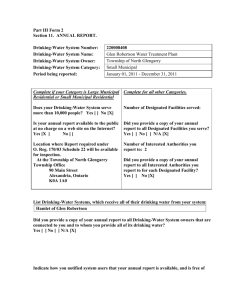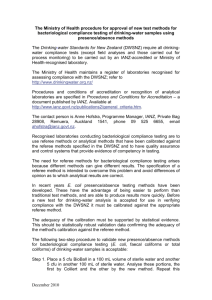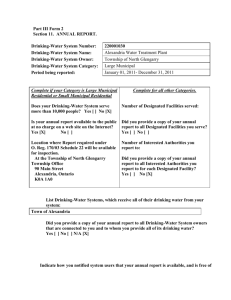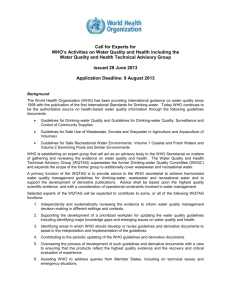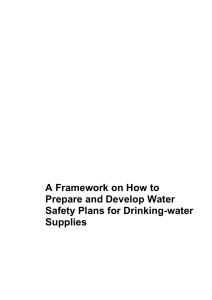Small Drinking-water Supplies: Water safety kit
advertisement
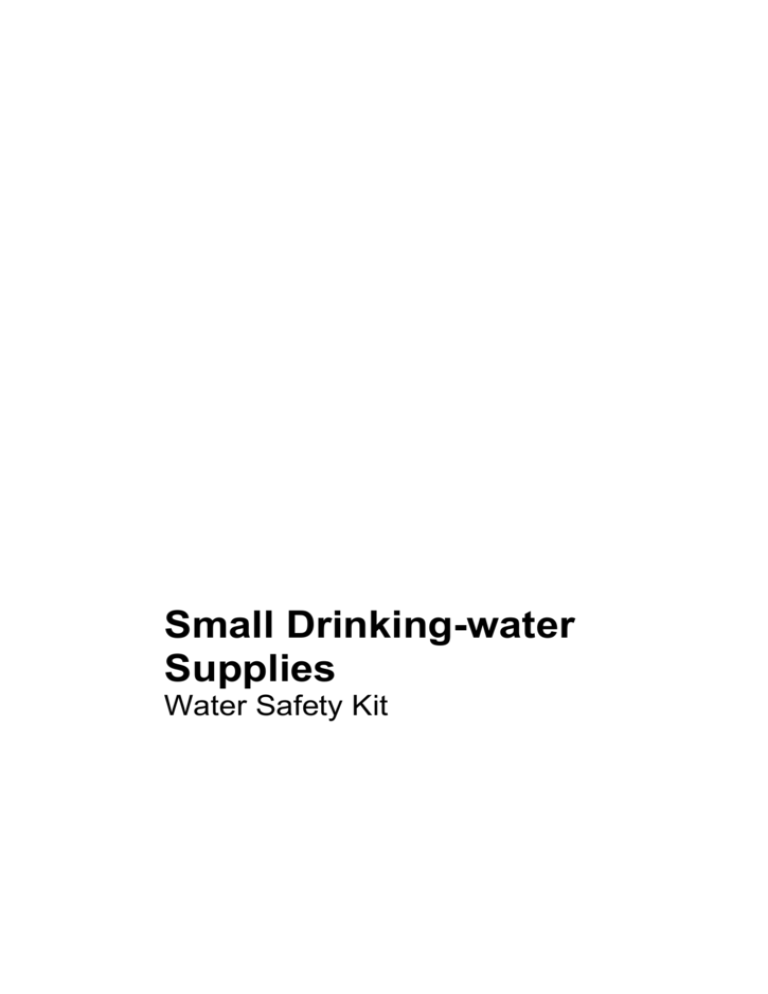
Small Drinking-water Supplies Water Safety Kit Citation: Ministry of Health. 2014. Small Drinking-water Supplies: Water safety kit. Wellington: Ministry of Health. Published in January 2014 by the Ministry of Health PO Box 5013, Wellington, New Zealand ISBN 978-0-478-41594-0 (print) ISBN 978-0-478-41595-7 (online) HP 4550 Previously published in 2008 as Small Drinking-water Supplies: Public Health Risk Management kit. This publication’s title and any reference within the text to ‘public health risk management’ was changed in January 2014 to reflect legislation change of the term ‘public health risk management’ to ‘water safety’. No other changes have been made to this document. This document is available at: www.health.govt.nz This work is licensed under the Creative Commons Attribution 4.0 International licence. In essence, you are free to: share ie, copy and redistribute the material in any medium or format; adapt ie, remix, transform and build upon the material. You must give appropriate credit, provide a link to the licence and indicate if changes were made. Small Drinking-water Supplies: Water safety kit In this pack are instructions and forms to help you to prepare a water safety plan (formerly known as a Public Health Risk Management Plan, PHRMP) for your drinkingwater supply. It has been designed to be put in a folder to help you keep information about your drinking-water supply together. Inside the pack is: an introduction that describes the purpose and benefits of a water safety plan, and outlines steps in preparing and using the water safety plan a template for preparing water safety plans. This is divided into sections with each divider showing you how to complete each section. Fill in the forms by hand, or download an electronic copy from www.health.govt.nz/water A Technical Assistance Programme (TAP) Facilitator at your local District Health Board can help you fill out the forms and provide you with further information. Small Drinking-water Supplies: Water safety kit iii Contents Small Drinking-water Supplies: Water safety kit 1 Why prepare a water safety plan? What is covered by the water safety plan? How to prepare a water safety plan What to do with the water safety plan Having your water safety plan approved Further information 1 1 2 2 3 3 Organisation Details 7 Step 1: Water Supply Description 9 Flow chart – initial thoughts Flow chart – final version 11 12 Step 2: Water Supply Assessment Prioritising what needs attention Judging priorities Catchment and intake Treatment Storage and distribution Other 13 23 24 25 27 29 31 Step 3: Planning to Manage What Needs Attention Catchment and intake Treatment Storage and distribution Other 33 35 37 39 41 Improvement Plan 43 Monitoring and Inspection Plan 45 Monitoring and Inspection Results 47 Emergency and Incident Plans 49 Example Incident Plan: Responding to microbiologically contaminated water Example Incident Plan: Investigating leaking or broken pipe Standard Operating and Maintenance Procedures 51 52 53 Example Standard Operating Procedure: Taking water samples for microbiological testing 55 Supporting Sign-Off/Approvals 57 Small Drinking-water Supplies: Water safety kit v Small Drinking-water Supplies: Water safety kit It is necessary for participating small drinking-water supplies to comply with the Drinking-water Standards for New Zealand 2005 (DWSNZ 2005) by preparing, using and updating a water safety plan (formerly known as Public Health Risk Management Plan, PHRMP). Why prepare a water safety plan? Water, whether it comes from a river, stream, lake, rain, spring or under the ground, may be unsafe to drink. What makes water safe is the care and consideration people have for activities and actions in the catchment, and in treatment, storage and distribution of the water. Water suppliers have a public health responsibility to their communities to provide drinking-water that is safe to drink. A well thought out water safety plan will provide consumer confidence of consistently safe drinking-water. A water safety plan give advice about improvements and expenditure, is a safeguard against changing operations staff and management, and is a learning resource for new staff. What is covered by the water safety plan? Preparing a water safety plan involves a systematic assessment of every aspect of providing safe drinking-water, identifying the events that could cause water to become unsafe to drink (including not enough water), and developing plans to manage these. The water safety plan covers three parts of the supply: catchment and intake treatment storage and distribution. The water safety plan helps identify whether any of the following four barriers to contamination are missing: minimising contamination of the source water removing particles from the water (where many of the pathogens/germs hide) killing or inactivating pathogens preventing recontamination after treatment. The water safety plan covers the following questions. 1. What could happen to cause the water to become unsafe to drink (including not enough water)? 2. Which of these factors need priority attention? Small Drinking-water Supplies: Water safety kit 1 3. 4. 5. How do you know when the water quality is deteriorating to a point where action is needed? How do you respond if action is needed? How do you stop this deterioration from happening in the future? How to prepare a water safety plan The following template will help you prepare a water safety plan for your supply. STEP 1 describes your drinking water supply. A good description of the water supply starts the process of identifying what could cause the water to become unsafe to drink. STEP 2 is based on the description of the water supply, and assesses in detail what is being managed well and where improvements are needed to ensure safe drinkingwater. This assessment answers questions 1 and 2 in the section above, and results in prioritising what needs attention. STEP 3 focuses on what needs attention and develops a plan to manage these. A Monitoring and Inspection Plan addresses question 3 in the section above. Emergency and Incident Plans and Standard Operating and Maintenance Procedures address question 4. An Improvement Plan addresses question 5. What to do with the water safety plan Use it for day-to-day actions and long-term planning. The water safety plan will: identify regular monitoring and inspections that signal deteriorating water quality and prompt action identify regular ongoing maintenance to reduce the chance of failure of any of the four barriers to contamination list where to get help, who needs to know about the water safety plan and drinkingwater quality, and how quickly they need to know provide direction for improvements and expenditure. Water safety is an ongoing process, so review your water safety plan at least annually. Update it after any significant change to your water supply, and if you find any weakness in your plan. 2 Small Drinking-water Supplies: Water safety kit Having your water safety plan approved Send your completed water safety plan to a Drinking-Water Assessor (DWA) at the local District Health Board for approval. Check you have included the following information in your water safety plan. Have you included? Tick if included Organisation details, including owner, contact details and supply name? A flow chart and/or schematic and/or photos to describe your supply from catchment to distribution? An assessment from catchment to distribution that identifies what could cause the water to become unsafe to drink, what could be done about it and prioritises what needs attention? An improvement plan to manage what needs attention, giving priority to areas of greatest concern and things that can be easy fixed, including timeframes and estimated costs? A monitoring and inspection plan that indicates when the water is becoming unsafe? Emergency and incident plans that describe what action will be taken if things go wrong in the meantime? The Drinking Water Assessor will assess your water safety plan and return it to you with a report within 20 working days. They may visit your supply periodically to see your progress in using your water safety plan. Further information For further information please contact either your Drinking Water Assessor or Technical Assistance Programme (TAP) Facilitator at the local District Health Board, or your Environmental Health Officer at your local council. You can also find more information on the specific components of a water supply at www.health.govt.nz/water. Small Drinking-water Supplies: Water safety kit 3 WATER SAFETY PLAN for [insert name of water supply] This document was prepared by........................................................................................ This document was prepared on ....................................................................................... This document is due for revision ...................................................................................... This document was approved by Water Supply Owner ..................................................... This document was approved by the Drinking Water Assessor ......................................... Small Drinking-water Supplies: Water safety kit 5 Organisation Details 1. Community name: ................................................................................................... 2. Supply owner/organisation name: ......................................................................... Contact person: ......................................................................................................... Postal address: ......................................................................................................... Contact phone number: ............................................................................................. Contact fax number: .................................................................................................. Contact email address: ............................................................................................. 3. Operator(s): ............................................................................................................. Contact person: ......................................................................................................... Postal address: ......................................................................................................... Contact phone number: ............................................................................................. Contact fax number: .................................................................................................. Contact email address: ............................................................................................. 4. Other organisation information: Eg, Board of Trustees, Incorporated Society Small Drinking-water Supplies: Water safety kit 7 Step 1: Water Supply Description Describing your water supply helps to identify what could cause the water to become unsafe to drink. Your description should include a flow or schematic diagram of the physical water supply system, including the catchment, intake, transfer to the treatment plant, the treatment process, storage facilities and distribution. The description should also include an outline of what the various people and organisations do in managing, operating and maintaining the water supply. Also record the volume and quality requirements of consumers. Refer to other documents such as maps and technical drawings to avoid duplication. Using photographs to illustrate key features is a good idea. Record your description using the blank flow charts on the following pages. Walk around the supply, including the catchment area. Small Drinking-water Supplies: Water safety kit 9 Flow chart – initial thoughts Catchment and intake: Treatment: Storage and distribution: Small Drinking-water Supplies: Water safety kit 11 Flow chart – final version Catchment and intake: Treatment: Storage and distribution: 12 Small Drinking-water Supplies: Water safety kit Step 2: Water Supply Assessment While your description of the water supply in Step 1 gives you a good understanding of the different components and features of the system, you usually have to look a little harder to identify what could cause the water to become unsafe to drink. This is called a water supply assessment. A water supply assessment gathers recent and historical information about the supply. It reminds you of previous problems, things that have been slowly changing, or sudden but short-lived changes and extreme events that have impacted on water quality and delivery. You can find useful information in: minutes of water supply committee meetings conversations with locals about changes in drinking water quality and quantity over the years, and significant events that have had an impact on the water supply records held by the DHB, eg, compliance with Drinking-water Standards, Public Health Grading monitoring and inspection records for the supply, and consumer complaint records council information about land and water use in the catchment and resource consent conditions, and water quality information. Use the following checklists to record your water supply assessment observations and findings. Using photographs to illustrate key features is a good idea. Small Drinking-water Supplies: Water safety kit 13 Every effort should be made to prevent contaminants entering the source water. For the CATCHMENT and INTAKE consider recent and historical information about: Access to the catchment by people (concerned about human faeces)? Access to the catchment by animals (concerned about animal faeces)? Discharges to catchment and pre-treatment storage such as effluent from farm practices, septic tanks and wastewater treatment plants, pesticide and fertiliser run-off or seepage, industrial waste, stormwater, seepage from landfills, underground tanks and pipes – all of which can affect surface water, springs and shallow groundwater? Able to provide enough water all year round? Small Drinking-water Supplies: Water safety kit 15 Natural events (eg, algal blooms, floods, drought and other natural disasters)? Condition of intake structure and accumulation of debris? Entry of contaminants down well or bore head? Deliberate damage to intake structure or bore head? Salt water intrusion? 16 Small Drinking-water Supplies: Water safety kit The treatment process needs to be operated in a manner that assures removal of contaminants, kills germs and does not add contaminants. For the TREATMENT PROCESS consider recent and historical information about: Possible causes of failed treatment for the treatment system you have, eg, chlorination, cartridge filtration, UV? Does the operator know immediately if a treatment process has failed and how do they know? Does the treatment system deal with the likely contaminants? Do the operational instructions match the equipment and how it is used? Small Drinking-water Supplies: Water safety kit 17 Condition of the treatment units and parts? Does the supply use approved parts and certified chemicals? Does the monitoring system have alarm indication and back-up equipment if faults occur? Maintenance, cleaning and personal hygiene practices while working at the treatment plant? Security against vandalism? 18 Small Drinking-water Supplies: Water safety kit Storage and distribution needs to be protected from contamination. For STORAGE and DISTRIBUTION consider recent and historical information about: Maintenance, cleaning and personal hygiene practices while working on the reservoirs/tanks and distribution system? Condition of reservoirs/tanks? Security against deliberate damage? Interconnections between your supply and a supplementary lesser quality supply (eg, an untreated stream supply that tops up a groundwater supply)? Small Drinking-water Supplies: Water safety kit 19 Illegal connections? Maintenance of consistent pressure in the system? Use of backflow prevention devices, particularly for high-risk connections (toxic chemicals or bugs) such as stock troughs, chemical dosing tanks and irrigation systems? Condition of pipes and fittings, releasing any build-up of corrosion products or sediment that has settled out from poor quality water, or allowing water from the surrounding area to seep into the pipes? 20 Small Drinking-water Supplies: Water safety kit OTHER things to consider: Back-up people to run and manage (make decisions) the water supply? Who will run and manage (make decisions) the water supply in the future? How decisions are made about the water supply, eg, a committee, an AGM? Are the people who run and manage the water supply adequately trained? Are there adequate instructions for people who run and manage the water supply? Small Drinking-water Supplies: Water safety kit 21 Prioritising what needs attention This section helps you to prioritise what needs attention, because you usually cannot deal with everything at once. In general, priority should be given to the events that will make people sick and will more than likely happen. Your notes in the previous section – Water Supply Assessment – will help you. Write down the events that could cause the water to become unsafe to drink (including not enough water) in the first column of the tables in this section. Then fill in the rest of the tables. Some of these events will already be adequately managed by routine inspections and maintenance. Other events will be ‘an accident waiting to happen’ with no plan in place of how to improve the situation. Some of these events will be more likely to happen than others, and some are more likely than others to make people sick. Use the tables over the page to judge priorities – follow steps 1 then 2 then 3. Alternatively, your gut feeling may be an OK way to judge priorities. Small Drinking-water Supplies: Water safety kit 23 Judging priorities 1. For each event, decide on the likelihood of it happening. Likelihood score Possible descriptions Almost certain Occurs like clockwork. Occurs every week, month, or season. Has occurred more than once before. Expected to occur every year. Has occurred before. Expected to occur every 2–5 years. Unlikely Has never occurred before, but expected to occur every 5–10 years. Rare Has never occurred before, and expected to occur less than once every 10 years. Likely Possible 2. For each event, decide on the consequence to people’s health if it did happen. Consequence score Possible descriptions Insignificant No illness expected in the community. Minor Very few of the community ill. Moderate Some of the community ill Major Most of the community ill. Catastrophic All of the community ill. Anticipate some deaths. 3. For each event, look up the likelihood and consequence scores in this table to find the corresponding priority (very low, low, medium, high, very high). Likelihood Consequence Insignificant Minor Moderate Major Catastrophic Almost certain Medium Medium High High Very high Likely Medium Medium Medium High High Possible Very low Low Medium High High Unlikely Very low Very low Low Medium High Rare Very low Very low Low Medium Medium 24 Small Drinking-water Supplies: Water safety kit Catchment and intake Describe what could cause water to become unsafe to drink (including not enough water) Is this under control now? If so, describe how it is being controlled. If not, judge whether the PRIORITY for attention is VERY HIGH, HIGH, MEDIUM, LOW or VERY LOW. You can use the previous tables to judge priorities. Make a comment to justify the priority. 1. 2. 3. 4. 5. 6. Small Drinking-water Supplies: Water safety kit 25 Describe what could cause water to become unsafe to drink (including not enough water) Is this under control now? If so, describe how it is being controlled. If not, judge whether the PRIORITY for attention is VERY HIGH, HIGH, MEDIUM, LOW or VERY LOW. You can use the previous tables to judge priorities. Make a comment to justify the priority. 7. 8. 9. 10. 11. 12. 26 Small Drinking-water Supplies: Water safety kit Treatment Describe what could cause water to become unsafe to drink (including not enough water) Is this under control now? If so, describe how it is being controlled. If not, judge whether the PRIORITY for attention is VERY HIGH, HIGH, MEDIUM, LOW or VERY LOW. You can use the previous tables to judge priorities. Make a comment to justify the priority. 13. 14. 15. 16. 17. 18. Small Drinking-water Supplies: Water safety kit 27 Describe what could cause water to become unsafe to drink (including not enough water) Is this under control now? If so, describe how it is being controlled. If not, judge whether the PRIORITY for attention is VERY HIGH, HIGH, MEDIUM, LOW or VERY LOW. You can use the previous tables to judge priorities. Make a comment to justify the priority. 19. 20. 21. 22. 23. 24. 28 Small Drinking-water Supplies: Water safety kit Storage and distribution Describe what could cause water to become unsafe to drink (including not enough water) Is this under control now? If so, describe how it is being controlled. If not, judge whether the PRIORITY for attention is VERY HIGH, HIGH, MEDIUM, LOW or VERY LOW. You can use the previous tables to judge priorities. Make a comment to justify the priority. 25. 26. 27. 28. 29. 30. Small Drinking-water Supplies: Water safety kit 29 Describe what could cause water to become unsafe to drink (including not enough water) Is this under control now? If so, describe how it is being controlled. If not, judge whether the PRIORITY for attention is VERY HIGH, HIGH, MEDIUM, LOW or VERY LOW. You can use the previous tables to judge priorities. Make a comment to justify the priority. 31. 32. 33. 34. 35. 36. 30 Small Drinking-water Supplies: Water safety kit Other Describe what could cause water to become unsafe to drink (including not enough water) Is this under control now? If so, describe how it is being controlled. If not, judge whether the PRIORITY for attention is VERY HIGH, HIGH, MEDIUM, LOW or VERY LOW. You can use the previous tables to judge priorities. Make a comment to justify the priority. 37. 38. 39. 40. 41. 42. Small Drinking-water Supplies: Water safety kit 31 Describe what could cause water to become unsafe to drink (including not enough water) Is this under control now? If so, describe how it is being controlled. If not, judge whether the PRIORITY for attention is VERY HIGH, HIGH, MEDIUM, LOW or VERY LOW. You can use the previous tables to judge priorities. Make a comment to justify the priority. 43. 44. 45. 46. 47. 48. 32 Small Drinking-water Supplies: Water safety kit Step 3: Planning to Manage What Needs Attention Now you have decided what needs priority attention so that the water does not become unsafe to drink, you need to think about what improvements will fix the problem. Some improvements will be a simple adjustment of something you are already doing. Some improvements will cost very little, and others could be more major. Even for those improvements that you cannot make straightaway, the risk of people getting sick remains. Think about temporary actions for these. It might be something like issuing a boil water notice, or manually shutting off the intake. You also need to find some sign/indicator/trigger that things are going wrong and that you need to take this temporary action. Copy all the events that need some attention from the previous section into the corresponding four tables in this section. Then fill in the rest of the tables. Small Drinking-water Supplies: Water safety kit 33 Catchment and intake Copy all of the events that need some attention from the Prioritising What Needs Attention section. Note the priority for attention. IMPROVEMENT SCHEDULE: How can you fix the problem? Until fixed, how will you know when this is actually causing unsafe drinking-water? More detail can be recorded in the Improvement Plan section. More detail can be recorded in the Monitoring & Inspection Plan section. What action will you take if things go wrong? More detail can be recorded in the Emergency & Incident Plan section. Small Drinking-water Supplies: Water safety kit 35 Copy all of the events that need some attention from the Prioritising What Needs Attention section. Note the priority for attention. 36 IMPROVEMENT SCHEDULE: How can you fix the problem? Until fixed, how will you know when this is actually causing unsafe drinking-water? More detail can be recorded in the Improvement Plan section. More detail can be recorded in the Monitoring & Inspection Plan section. Small Drinking-water Supplies: Water safety kit What action will you take if things go wrong? More detail can be recorded in the Emergency & Incident Plan section. Treatment Copy all of the events that need some attention from the Prioritising What Needs Attention section. Note the priority for attention. IMPROVEMENT SCHEDULE: How can you fix the problem? Until fixed, how will you know when this is actually causing unsafe drinking-water? More detail can be recorded in the Improvement Plan section. More detail can be recorded in the Monitoring & Inspection Plan section. What action will you take if things go wrong? More detail can be recorded in the Emergency & Incident Plan section. Small Drinking-water Supplies: Water safety kit 37 Copy all of the events that need some attention from the Prioritising What Needs Attention section. Note the priority for attention. 38 IMPROVEMENT SCHEDULE: How can you fix the problem? Until fixed, how will you know when this is actually causing unsafe drinking-water? More detail can be recorded in the Improvement Plan section. More detail can be recorded in the Monitoring & Inspection Plan section. Small Drinking-water Supplies: Water safety kit What action will you take if things go wrong? More detail can be recorded in the Emergency & Incident Plan section. Storage and distribution Copy all of the events that need some attention from the Prioritising What Needs Attention section. Note the priority for attention. IMPROVEMENT SCHEDULE: How can you fix the problem? Until fixed, how will you know when this is actually causing unsafe drinking-water? More detail can be recorded in the Improvement Plan section. More detail can be recorded in the Monitoring & Inspection Plan section. What action will you take if things go wrong? More detail can be recorded in the Emergency & Incident Plan section. Small Drinking-water Supplies: Water safety kit 39 Copy all of the events that need some attention from the Prioritising What Needs Attention section. Note the priority for attention. 40 IMPROVEMENT SCHEDULE: How can you fix the problem? Until fixed, how will you know when this is actually causing unsafe drinking-water? More detail can be recorded in the Improvement Plan section. More detail can be recorded in the Monitoring & Inspection Plan section. Small Drinking-water Supplies: Water safety kit What action will you take if things go wrong? More detail can be recorded in the Emergency & Incident Plan section. Other Copy all of the events that need some attention from the Prioritising What Needs Attention section. Note the priority for attention. IMPROVEMENT SCHEDULE: How can you fix the problem? Until fixed, how will you know when this is actually causing unsafe drinking-water? More detail can be recorded in the Improvement Plan section. More detail can be recorded in the Monitoring & Inspection Plan section. What action will you take if things go wrong? More detail can be recorded in the Emergency & Incident Plan section. Small Drinking-water Supplies: Water safety kit 41 Copy all of the events that need some attention from the Prioritising What Needs Attention section. Note the priority for attention. 42 IMPROVEMENT SCHEDULE: How can you fix the problem? Until fixed, how will you know when this is actually causing unsafe drinking-water? More detail can be recorded in the Improvement Plan section. More detail can be recorded in the Monitoring & Inspection Plan section. Small Drinking-water Supplies: Water safety kit What action will you take if things go wrong? More detail can be recorded in the Emergency & Incident Plan section. Improvement Plan This section helps you to think about detailed planning for the improvements that you have identified in the Planning to Manage What Needs Attention section. Focus on the improvements that are identified as having the highest priority for attention. But it’s also satisfying to complete improvements that take very little time and money, even if these are lower priority. For each improvement, the plan should cover: a breakdown into significant practical steps, eg, gather quotes, obtain approval estimated costs and people/expertise needed a named person responsible for ensuring progress on the improvement the timeframe for the improvement. It may be helpful to organise the improvements into categories such as: improved operations and maintenance preparing documentation, such as Standard Operating Procedures, Emergency & Incident Plans investigations, such as a catchment assessment or a new source training for key staff or back-up people minor purchases major infrastructure purchase. Small Drinking-water Supplies: Water safety kit 43 Monitoring and Inspection Plan Monitoring and inspection (observations) of the drinking-water supply is a critical part of managing what can cause the water supply to become unsafe to drink. The results of monitoring and inspection can demonstrate that parts of the supply continue to be well managed, or that something needs attention. Monitoring and inspection results can trigger temporary action when things go wrong. Important monitoring and inspections for your supply have already been identified in: Prioritising What Needs Attention section, under the column Is this under control now? If so, describe how it is being controlled. Planning to Manage What Needs Attention section, under the column Until fixed, how will you know when this is actually causing unsafe drinking-water? In your Monitoring and Inspection Plan you should include: what you are looking for (eg, observations like stock access, or monitoring results) how frequently you make the inspection or monitor (eg, daily, weekly, monthly, annually) the trigger for immediate action what immediate action you will take, including who needs to know and how urgently a place for a tick/signature to say the monitoring/inspection has been done. Small Drinking-water Supplies: Water safety kit 45 Monitoring and Inspection Results It is important to keep records of monitoring and inspection results and any actions that have been taken in response to the results. It would be sensible to organise the records so they match the way you organised the Monitoring and Inspection Plan in the previous section, eg, into daily, weekly, monthly, and annual records. Periodically look over the results for signs of anything changing that relates to the water to become unsafe to drink, eg, a gradual increase over the months or years in a chemical contaminant like nitrate, or a seasonal occurrence of algae. Small Drinking-water Supplies: Water safety kit 47 Emergency and Incident Plans You have identified some important public health risks to your water supply. You know that addressing some of these risks will take some time, and in the Planning to Manage What Needs Attention section you have worked out early warning signs to alert you to take some temporary action in the meantime. This section helps you to think about detailed planning of these temporary actions. Incident Plans are your more routine plans, restoring safe drinking-water before it causes a major public health problem. These plans should be used when the early warning signs of routine monitoring and inspection alert you. For example, fixing a broken pipe, or shutting off the intake during heavy rain, maybe resulting in the need to issue a boil water notice. Examples of two incident plans are provided: (i) responding to microbiologically contaminated water, (ii) investigating a leaking or broken pipe. Emergency Plans help you to respond when the water quality has become seriously bad. These typically need to be used with little-to-no warning. Examples include major microbiological or chemical contamination as a result of earthquakes, floods, cyclones, or volcanic activity. Both levels of response plans require prompt action, so require pre-arranging so that everyone involved is aware of the plan and what they have to do. Emergency plan responses often require rapid decisions to be made without a complete understanding of the situation. Someone needs to be responsible for making these decisions. Small Drinking-water Supplies: Water safety kit 49 Example Incident Plan: Responding to microbiologically contaminated water Early warning signs Actions required Responsibility Complaints of discoloured, tasting or smelling water coming from taps. Evidence of stock access to source water. A detectable chlorine residual cannot be obtained in the tap water. E coli detected in routine monitoring of the tap water. Reports of illness in the community that may be linked to water quality. Consider whether to cease abstraction and switch to an alternative source of drinking-water until water of acceptable quality can again be supplied, or to use storage. Notify the Medical Officer of Health, and in consultation warn consumers in the affected area not to draw water until further notice, and consider whether to issue a boil water notice (refer to boil water notice procedure). Identify what is causing the contamination, and how to stop the contamination. If the contamination can be stopped, drain and flush the affected part of the distribution system, considering the need to flush with elevated chlorine concentration (refer to emergency distribution system chlorination procedure). Monitor chlorine residual in the affected area to determine the success of the flushing, and notify consumers, when the supply is safe to use, that they will need to flush their taps and storage tanks until good quality water an again be drawn. If the contamination is a more permanent problem, investigate and develop an alternative supply and/or treatment. Record what went wrong and why, and what you have done to overcome the problems. Modify your water safety plan if necessary. Water supply committee chairperson Technical or operations manager Small Drinking-water Supplies: Water safety kit 51 Example Incident Plan: Investigating leaking or broken pipe START Find the leak/break Yes Does the water in the distribution have an adequate chlorine residual? No (chlorinated supplies) Yes Was the distribution pipe fully or partially without water? No (non-chlorinated supplies) IMMEDIATELY contact Medical Officer of Health. Warn consumers not to use water. Consider issuing “Boil Water Notice” No Isolate affected section of distribution if possible Isolate affected section of distribution if possible Isolate affected section of distribution if possible Complete repair Complete repair Complete repair Disinfect with elevated chlorine concentration Disinfect with elevated chlorine concentration Flush to waste until chlorine residual reaches normal level Flush to waste Flush to waste until chlorine residual reaches normal level Reconnect affected section of distribution Reconnect affected section of distribution Advise households to flush storage tanks and taps Advise households to flush storage tanks and taps Immediately collect E.coli samples STOP 52 Remove “Boil Water Notice”. No further action necessary Yes Are samples negative on three consecutive days? Small Drinking-water Supplies: Water safety kit No Notify Medical Officer of Health. Discuss actions. Consider issuing “Boil Water Notice” Standard Operating and Maintenance Procedures This section is a place for you to file current versions of all the routine activities of maintaining and operating your drinking-water supply that require some kind of instruction. These have been referred to in the Prioritising What Needs Attention and Planning to Manage What Needs Attention sections. Ask yourself the question ‘If the operator cannot attend to the water supply today, is there sufficient instructions about how to run the supply available for whoever stands in?’ An example of a Standard Operating Procedure (SOP) is provided: taking water samples for microbiological testing. SOPs need to be written in a way that makes sense to the person who uses the SOP. A copy of each SOP should be displayed at the place where it is used, for example the pump maintenance SOP should be in the pump house. Small Drinking-water Supplies: Water safety kit 53 Example Standard Operating Procedure: Taking water samples for microbiological testing [Diagrams or photos could be included] Use this procedure for the monthly water quality testing, and for any emergency microbiological sampling. Reminders Only use the sterilised glass sample bottles provided by the laboratory. Do not use a bottle that has had the cap removed, opened or damaged. If you use the last bottle, tell the committee secretary so more can be ordered. Take water samples from the designated sampling taps (see map). Before taking the sample Wash hands thoroughly. Fill in the label on the bottle and the laboratory form BEFORE collecting the water sample. (It is very hard to write on a wet label.) Remove attachments from the tap and wipe with a clean cloth or paper towel. Turn on the tap and flush for 2 to 3 minutes to remove any stagnated water. Turn off the tap. Sterilise the tap outlet by flaming the tap (using a gas burner) starting at the nozzle and working back to the body of the tap until the water in the spout boils. Alternatively, apply 1% solution of sodium hypochlorite solution using a sterile swab or spray from a wash bottle (inside and outside surfaces). Leave for 2 to 3 minutes before taking the sample. Take care not to get the sodium hypochlorite solution into the sample. Taking the sample Turn on the tap again to cool or rinse out residual disinfectant. Remove the sample bottle cap just before taking the sample. Be careful not to touch the inside of the cap, the seal or neck of the bottle, or put the cap down on a surface where it might become contaminated. Leave the water running and fill the glass sample bottle. Do not rinse the sample bottle. Do not fill the bottle completely; leave about 3 cm space. Replace the cap immediately. Turn off the tap. After taking the sample Package the sample bottle so it does not break and is kept cool (a chilly bin with ice pack), for delivery to the laboratory. Send the sample off to the laboratory as soon as possible, to arrive at the laboratory ideally within six hours and not more than 24 hours after collection. Small Drinking-water Supplies: Water safety kit 55 Supporting Sign-Off/Approvals This section is a place for you to file other related documents/approvals, for example: resource consents land ownership arrangements DWA water safety plan approval documentation Annual Drinking-water Standards compliance report. Small Drinking-water Supplies: Water safety kit 57

